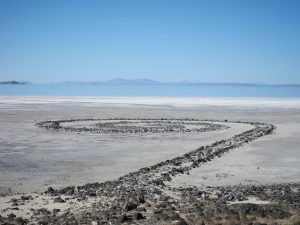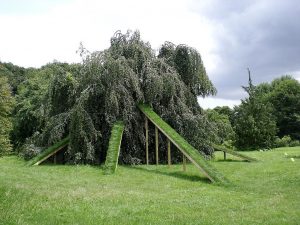STUDENT EXAMPLE: Land Art – “Our Place”
Our Place



This portfolio titled “Our place” is about Earth art (also referred to as land art in some instances) and the way it affects the audience allowing them to recognize their place on Earth. One way Earth art is especially important to me is through the fact that the medium used in this art is the land itself, giving the artwork a completely different feeling and sense of scale. Earth art is also typically done with an environmentally friendly approach so that after the installation is complete, nature may take over the work and restore the land to how it was before. The artists and works that I will be addressing in this portfolio are Robert Smithson, Andy Goldsworthy, and Nils Udo. These artists all have made earth works that allow the audience to realize their presence in nature and immerse themselves.
Two themes that my portfolio will be addressing are experiencing nature, as well as our place in nature. The first theme of experiencing nature is present in the land art of the artists that are represented in this portfolio. These works draw the viewer to the nature around them and fully immerse them in the experience. The second theme, the audience’s place in nature, is equally important since it allows the audience to reflect on the work and realize that they have a place in this world, that it is not just them on this earth and that they should respect it accordingly.
The first image is of Robert Smithson’s Spiral Jetty in Great Salt Lake, Utah. This work uses black basalt rocks and earth from the site to form this counterclockwise 1500 feet long spiral offshore into the water. This spiral resembles the space of a galaxy especially since space was one of Smithson’s inspirations at the time due to the moon landing having happened recently. This, in turn, contributed to the desire for the audience to experience a sense of smallness while walking through this spiral. The second image is of Nil Udo’s installation Towards Nature. This artwork uses 4 earth ramps going into a tree in the center to symbolize our unconscious link to nature. This artwork was meant to symbolize the gap between humanity and nature and attempt to bridge the two together, making humanity more conscious of their link to it. The third and final image is of Andy Goldsworthy’s Wood Line, this work is located in a large Eucalyptus grove in Presidio, San Francisco. This work fills a space in this grove with curving eucalyptus branches that were taken from projects where trees needed to be removed. This piece was created with the intent that it allows the audience to let these branches “draw” the flow through the space, as well as eventually the eucalyptus branches will go back into the ground and back to nature.
Earth art such as the works discussed in this portfolio are important because they give audiences a non-conventional way to connect with the environment through contemporary art. Unlike art forms that point out things wrong with the environment to acheive awarness, earth art does this through giving the audience connection with nature which leads to the realization that they are not alone on this planet. Which draws another reason of the importance of earth art, the fact that this is achieved through ecological means that do not harm the environment but rather are made with the intent of letting nature take over and allowing the piece to take back its place in nature. The earth art in this portfolio was made with the intention so that we as a society may understand our place in nature and respect it as so.

